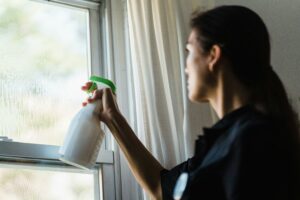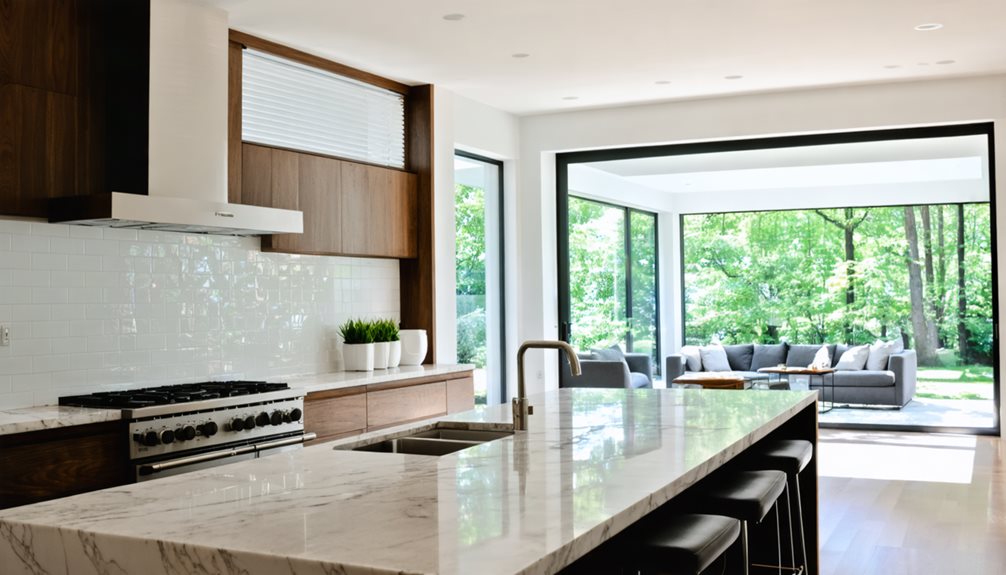Post-construction cleaning transforms a construction site into a livable space through systematic debris removal and thorough sanitization. Professional services employ specialized HEPA vacuums and industrial-grade equipment to tackle stubborn residues, settled dust, and hidden contaminants. The process typically unfolds in three phases: rough clean, light clean, and final clean, guaranteeing no area is overlooked. While DIY approaches are possible, trained professionals follow detailed checklists and utilize advanced tools for superior results. A well-executed cleaning plan, combined with regular maintenance, preserves the investment and creates a healthy environment. Understanding the complete process helps guarantee the best transformation of your newly renovated space.
Key Takeaways
- Professional post-construction cleaning services utilize HEPA vacuums and industrial equipment to remove hazardous materials, dust, and construction debris effectively.
- The three-phase cleaning process includes rough cleaning, light cleaning, and final detailing to ensure comprehensive transformation.
- Thorough cleaning of hidden areas like HVAC systems and removal of stubborn residues requires specialized tools and expertise.
- Early scheduling of cleanup prevents deep dust settling and protects your investment in renovation.
- Regular maintenance following a structured cleaning schedule preserves the space’s pristine condition and promotes a healthy environment.
Understanding Post-Construction Cleaning Essentials
In the aftermath of construction work, thorough cleaning becomes a critical step to transform a work site into a habitable space. Post-renovation cleaning requires careful attention to detail and systematic execution to guarantee the removal of potentially hazardous materials, construction dust, and debris that can compromise indoor air quality.
The cleaning process typically unfolds in three distinct phases, each targeting specific aspects of the renovated space. Beginning with a rough clean to remove larger debris, followed by a light clean for intermediate details, and concluding with a final clean that achieves a polished finish. Professional post-construction cleaning services bring expertise and specialized equipment, including HEPA vacuums and industrial-grade tools, making them particularly effective for comprehensive site cleanup.
Success in post-renovation cleaning relies heavily on a methodical approach, utilizing detailed checklists and room-by-room progression to ensure no area is overlooked. This systematic strategy, combined with proper safety equipment and cleaning tools, helps create a safe, clean environment while protecting both cleaning personnel and future occupants from construction-related contaminants. The thorough cleaning process ultimately bridges the gap between construction completion and space utilization.
Common Challenges During Site Cleanup
While post-construction cleanup appears straightforward, several significant challenges can impede the process and compromise the final results. One of the most persistent issues is the presence of settled dust and fine particles that infiltrate every surface, including hard-to-reach areas and air vents, requiring specialized equipment with HEPA filters for thorough removal.
Construction dust poses particular challenges in hidden areas, such as HVAC systems and spaces behind fixtures, which are frequently overlooked during the initial cleaning process. Additionally, stubborn residues like paint splatters and adhesive remnants demand specific tools and solvents for effective elimination, further complicating the cleanup procedure.
A comprehensive approach to post-construction cleanup must also address compliance with local regulations regarding debris disposal. Improper handling of construction waste can result in significant legal penalties and environmental consequences. The time-intensive nature of thorough cleaning necessitates careful planning and systematic execution to guarantee no area is missed. Success in overcoming these challenges requires both expertise and attention to detail, particularly when dealing with complex cleaning requirements in newly renovated spaces.

Professional Versus DIY Approaches
The decision between professional and DIY approaches to post-construction cleaning hinges on essential factors that impact both the quality and efficiency of the final result. Professional cleaning services utilize specialized equipment like HEPA vacuums and employ systematic approaches that guarantee comprehensive coverage of all areas, including hidden spaces that DIY methods might overlook. The expertise of trained professionals significantly reduces cleaning time while delivering superior results in terms of thoroughness and indoor air quality.
- Professional teams use industrial-grade equipment specifically designed for post-construction cleaning, effectively removing fine dust and hazardous materials that standard household tools cannot adequately address
- Trained cleaners follow detailed checklists and protocols, guaranteeing no area is missed, including HVAC systems and other concealed spaces that impact long-term air quality
- While DIY methods may appear cost-effective initially, they often require multiple attempts and may leave behind harmful VOCs and allergens that affect the overall success of the renovation project
The investment in professional services ultimately delivers value through expertise, efficiency, and the confidence that your newly renovated space is thoroughly cleaned to the highest standards.
Smart Planning For Better Results
Smart planning transforms post-construction cleaning from a challenging task into a manageable, systematic process that yields superior results. By implementing strategic preparation steps, house cleaning services can guarantee your complete satisfaction while efficiently managing the post-construction cleaning process.
Effective planning begins with coordinating cleanup timing with contractors, making certain all construction materials are removed before the detailed cleaning commences. Protecting existing furniture and equipment with appropriate coverings prevents unnecessary dust accumulation, while clearing access routes enables highly trained cleaning teams to work efficiently throughout the space. This methodical approach significantly impacts the final outcome, allowing you to fully enjoy your newly renovated space sooner.
Communication plays an essential role in smart planning, as discussing specific requirements with your chosen cleaning service helps create a customized cleaning strategy. This proactive approach allows professionals to address unique challenges and prioritize areas of concern. By scheduling the clean house process promptly after construction completion, you prevent dust from settling deeply into surfaces, making the overall cleaning process more effective and thorough. This systematic preparation guarantees ideal results and a pristine finished space.
Maintaining Your Renewed Space
Maintaining pristine conditions in your newly renovated space requires a well-structured maintenance plan and consistent execution. A systematic approach to post-construction cleaning, performed at least bi-weekly, guarantees that your renovated space retains its appeal while promoting a healthy environment. By implementing a designated cleaning routine that moves from top to bottom, you prevent dust and debris from contaminating previously cleaned areas.
To maintain peak indoor air quality and preserve your renovation investment, focus on:
- Regular cleaning of windows and ventilation systems to minimize respiratory risks from construction dust and volatile organic compounds (VOCs)
- Implementation of a detailed routine maintenance checklist to track and complete essential cleaning tasks systematically
- Consistent execution of cleaning protocols to extend the lifespan of surfaces and fixtures
The key to successful maintenance lies in establishing and following a structured cleaning schedule. This proactive approach not only preserves the aesthetic appeal of your space but also protects your investment by preventing premature wear and deterioration. Through diligent adherence to these maintenance practices, your renovated space will continue to showcase its intended beauty while providing a healthy environment for occupants.
Frequently Asked Questions
Is Post-Renovation Cleaning Worth It?
Ah, who doesn’t love living amongst construction dust and finding random nails in unexpected places? But seriously, post-renovation cleaning is absolutely worth the investment. Professional cleaning services save 10-20 hours of labor, effectively remove harmful VOCs and debris, and guarantee proper disposal of hazardous materials. Beyond the immediate health benefits, it improves property value and creates a safe, move-in ready environment that meets regulatory standards.
How Much Does Post Construction Cleaning Cost?
Post-construction cleaning costs typically range from $0.10 to $0.50 per square foot, with most homeowners spending between $200 and $800 for comprehensive services. The final price depends on several factors, including square footage, level of cleaning required, debris removal needs, and geographic location. Additional services like window washing or appliance deep cleaning may increase costs. It’s recommended to obtain multiple quotes from cleaning companies to guarantee competitive pricing.
What Does Post-Renovation Cleaning Include?
Post-renovation cleaning encompasses comprehensive services to restore a space after construction work. This includes detailed dusting of walls, ceilings, and fixtures; thorough floor cleaning with vacuuming and mopping; window and glass surface cleaning to remove paint splatters and smudges; sanitization of kitchens and bathrooms; and removal of construction debris. Professional cleaners typically follow a detailed checklist to guarantee all areas are properly addressed, including HVAC vents and light fixtures.
What Does Post Construction Cleaning Mean?
Post-construction cleaning is a comprehensive cleaning service performed after construction or renovation work is completed. This specialized process involves removing construction debris, dust, paint overspray, and other residual materials from all surfaces. It typically includes multiple phases: rough cleaning to remove large debris, detail cleaning of fixtures and surfaces, and final cleaning to achieve a polished, move-in ready condition that meets safety and cleanliness standards.





